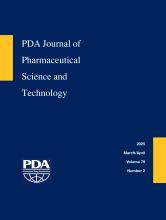Abstract
Visible particles may potentially pose safety and efficacy concerns if inadvertently administered to patients; therefore, it is crucial to monitor and characterize these particles. These particles may be composed of proteinaceous and non-proteinaceous material. While particles made of non-proteinaceous material are unacceptable in drug products, proteinaceous particles may be acceptable on a case-by-case basis if characterized and shown not to pose quality, efficacy, and safety concerns. The focus of this manuscript is on the proteinaceous particles that may potentially form in some biopharmaceuticals. Monitoring and tracking proteinaceous particles in these biotherapeutics can be challenging but a universal protein-like particle standard might be able to help. The aim of this work is to evaluate abraded ethylene tetrafluoroethylene (ETFE) as a visible protein-like particle standard and demonstrate a semi-quantitative method to show how this surrogate can be used to effectively monitor proteinaceous particles during formulation and analytical development. Studies indicated that the ETFE particles in solution better mimic the appearance and behavior of protein particles than commonly used polystyrene microsphere standards and therefore could be a viable standard for visible proteinaceous particles. Such standards and the semi-quantitative method illustrated could be used effectively during development to non-destructively identify potential stability problems.
- ethylene tetrafluoroethylene
- protein aggregation
- protein particle standard
- proteinaceous visible particles
- proteins
- stability
- Received May 10, 2018.
- Accepted February 27, 2019.
- Copyright © 2019, Parenteral Drug Association
PDA members receive access to all articles published in the current year and previous volume year. Institutional subscribers received access to all content. Log in below to receive access to this article if you are either of these.
If you are neither or you are a PDA member trying to access an article outside of your membership license, then you must purchase access to this article (below). If you do not have a username or password for JPST, you will be required to create an account prior to purchasing.
Full issue PDFs are for PDA members only.
Note to pda.org users
The PDA and PDA bookstore websites (www.pda.org and www.pda.org/bookstore) are separate websites from the PDA JPST website. When you first join PDA, your initial UserID and Password are sent to HighWirePress to create your PDA JPST account. Subsequent UserrID and Password changes required at the PDA websites will not pass on to PDA JPST and vice versa. If you forget your PDA JPST UserID and/or Password, you can request help to retrieve UserID and reset Password below.






